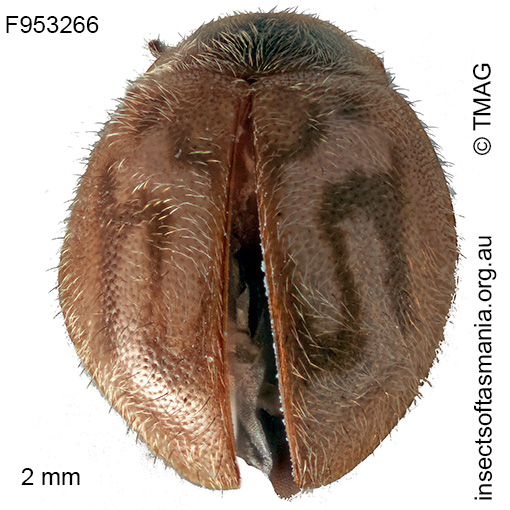
Rhyzobius alphabeticus Lea, 1902 (a species of ladybird)
Basis for Tasmanian occurrence
Semmens, T.D., McQuillan, P.B. & Hayhurst, G. (1992). Catalogue of the Insects of Tasmania. Government of Tasmania: Department of Primary Industry, 104 pp. (as Rhyzobius alphabeticus)
TMAG collections
Classification
Order: Coleoptera
Suborder: Polyphaga
Superfamily: Coccinelloidea
Family: Coccinellidae
Subfamily: Coccinellinae
Tribe: Coccidulini
Morphology
Typical length (mm): 2
Flightedness: winged and assumed capable of flight.
Ecology
Assumed larval feeding: (not yet documented)
Association with dead wood or old trees: at least facultatively saproxylic
Ecological attributes: — Affiliated with bark on non-wounded trees (Harrison, 2007) — May occupy logs or trunks of Eucalyptus obliqua, at least temporarily, since found having emerged within six years of felling (Grove et al., 2009).
Collection method(s) for TMAG material: — Beating foliage of Dicksonia antarctica (Jones, 2007) — Emergence trapping from log of Eucalyptus obliqua — Knockdown fogging of canopy of Athrotaxis selaginoides — Knockdown fogging of canopy of Nothofagus cunninghamii — Knockdown fogging of canopy of Nothofagus gunnii — Malaise trapping — Pitfall trapping.
Source ecological literature:
Grove, S. et al. (2009). A long-term experimental study of saproxylic beetle … succession in Tasmanian Eucalyptus … logs… In: Fattorini, S. (Ed.), Insect Ecology and Conservation. Research Signpost, pp. 71-114.
Jones, N.M. (2007). Tree fern invertebrates: variation of invertebrate assemblages on the tree fern Dicksonia antarctica and its quarantine applications. Hons. thesis, Univ. of Tasmania, Hobart.
Yee, M. (2005). The ecology and habitat requirements of saproxylic beetles native to Tasmanian wet eucalypt forests: potential impacts of commercial forestry practices. PhD thesis, Univ. of Tasmania, Hobart.

